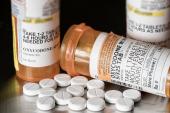Rising Endocarditis and Neurovascular Events Linked to Opioid Epidemic
As the end of the COVID-19 pandemic nears, efforts to combat the opioid problem need to be redoubled, a researcher says.

The dramatic rise in opioid abuse over the past few decades appears to be increasing cases of infective endocarditis as well as various related neurovascular complications, a study shows.
At a single center in Ohio, which has been particularly hard-hit by the opioid epidemic, there was a 630% increase in the incidence of endocarditis associated with IV drug use over a recent 4-and-a-half-year span, according to Shahid Nimjee, MD, PhD (Ohio State University Wexner Medical Center, Columbus).
Among patients with endocarditis, IV drug use was associated with a greater risk of hemorrhagic stroke, increased use of diagnostic tests and therapeutic interventions, as well as higher costs, he reported as part of the virtual International Stroke Conference 2021, which starts tomorrow.
Nimjee told TCTMD his group wanted to look into this issue because there was a noticeable increase in recent years in the number of young people coming in with strokes, endocarditis, and a history of IV drug use. The goal was to generate solid numbers to highlight the issue.
“It’s going to take this kind of research and others like it that will allow people to reference data and say, ‘This is a really big problem. This is affecting us medically, socially, and financially, and we need to bring hard resources to this so that we can solve it,’” he urged.
This is affecting us medically, socially, and financially, and we need to bring hard resources to this so that we can solve it. Shahid Nimjee
“If we include this now in increasing someone's risk of stroke, that's something to think about when people come into the hospital or when they're being treated for opioid abuse, to explain that this is a risk factor and should be taken seriously in terms of their medical health,” she said in a recorded commentary.
The investigators performed a retrospective study of 351 patients treated for infective endocarditis at their center between January 1, 2014, and July 1, 2018; slightly fewer than half of cases (48%) were related to IV drug use.
The marked increase in the number of cases related to drug abuse that they recorded is particularly concerning in light of the fact that among patients with endocarditis, IV drug users had a higher rate of intracranial hemorrhage (25.9% vs 13.9%; P = 0.005). That was driven by increased rates of intraparenchymal hemorrhage (12.4% vs 5.1%; P = 0.012), subarachnoid hemorrhage (17.6% vs 4.4%; P = 0.0001), and cerebral microbleeds (14.1% vs 7.2%, P = 0.022).
Drug users also were more likely to have infectious intracranial aneurysms (10.6% vs 1.8%; P = 0.0001) and brain abscesses (4.7% vs 1.1%; P = 0.025).
Nimjee said that when a young person presents with stroke, endocarditis related to IV drug use should be considered as a potential etiology. “Immediately think about things like echocardiograms and think about doing a further workup if they have a neurological deficit for a stroke and follow that through,” he advised. “I think if we’re quicker to go down that diagnostic pathway, then we’ll be able to treat that individual patient more efficiently. . . . While it doesn’t address the whole issue of the opioid epidemic, I’m hoping it allows us to move forward so that we start with individual patients and move to entire systems of care.”
But ultimately, “I think it’s going to take a real engineered engagement from states, and from the nation, to overcome this,” Nimjee said, indicating that the opioid epidemic has been overshadowed by the COVID-19 emergency. Indeed, the American Medical Association has put out an issue brief highlighting concerns that the opioid problem may be worsening while the world focuses on stemming the spread of SARS-CoV-2.
“My hope is as we continue to progress through the pandemic that we’ll be able to turn our attention again to the opioid epidemic and understand it more fully with research like this and then start developing durable solutions,” Nimjee said. “As soon as this is done, this pandemic, if we don’t spend a substantial amount of time, effort, and resources into dealing with the opioid epidemic, this is something that we’re going to be plagued with for a long time.”
Todd Neale is the Associate News Editor for TCTMD and a Senior Medical Journalist. He got his start in journalism at …
Read Full BioSources
Hoang N, Powers C, Nimjee SM, et al. Epidemiology and stroke complications of IVDU-associated endocarditis in the heart of the opioid epidemic. Presented at: ISC 2021.
Disclosures
- Nimjee reports no relevant conflicts of interest.





Comments